Analyzing Balanced Scorecard Implementation at Nestle Company
VerifiedAdded on 2021/05/31
|17
|4160
|41
Report
AI Summary
This report provides a comprehensive analysis of the Balanced Scorecard system and its application within Nestle Company. It begins with an executive summary and introduction, followed by an overview of Nestle, highlighting its position as a leading global food and beverage company. The core of the report focuses on the Balanced Scorecard, detailing its four perspectives (financial, customer, internal business processes, and learning and growth), its features, and its implementation within Nestle. The report also contrasts the Balanced Scorecard with traditional performance measurement systems, emphasizing the limitations of solely financial metrics. Furthermore, it assesses the suitability of the Balanced Scorecard for Nestle, covering operational activities, performance analysis, and strategic objective clarification. The conclusion summarizes the key findings, emphasizing the benefits of the Balanced Scorecard for comprehensive performance management within Nestle.

Management Accounting
Nestle
Nestle
Paraphrase This Document
Need a fresh take? Get an instant paraphrase of this document with our AI Paraphraser
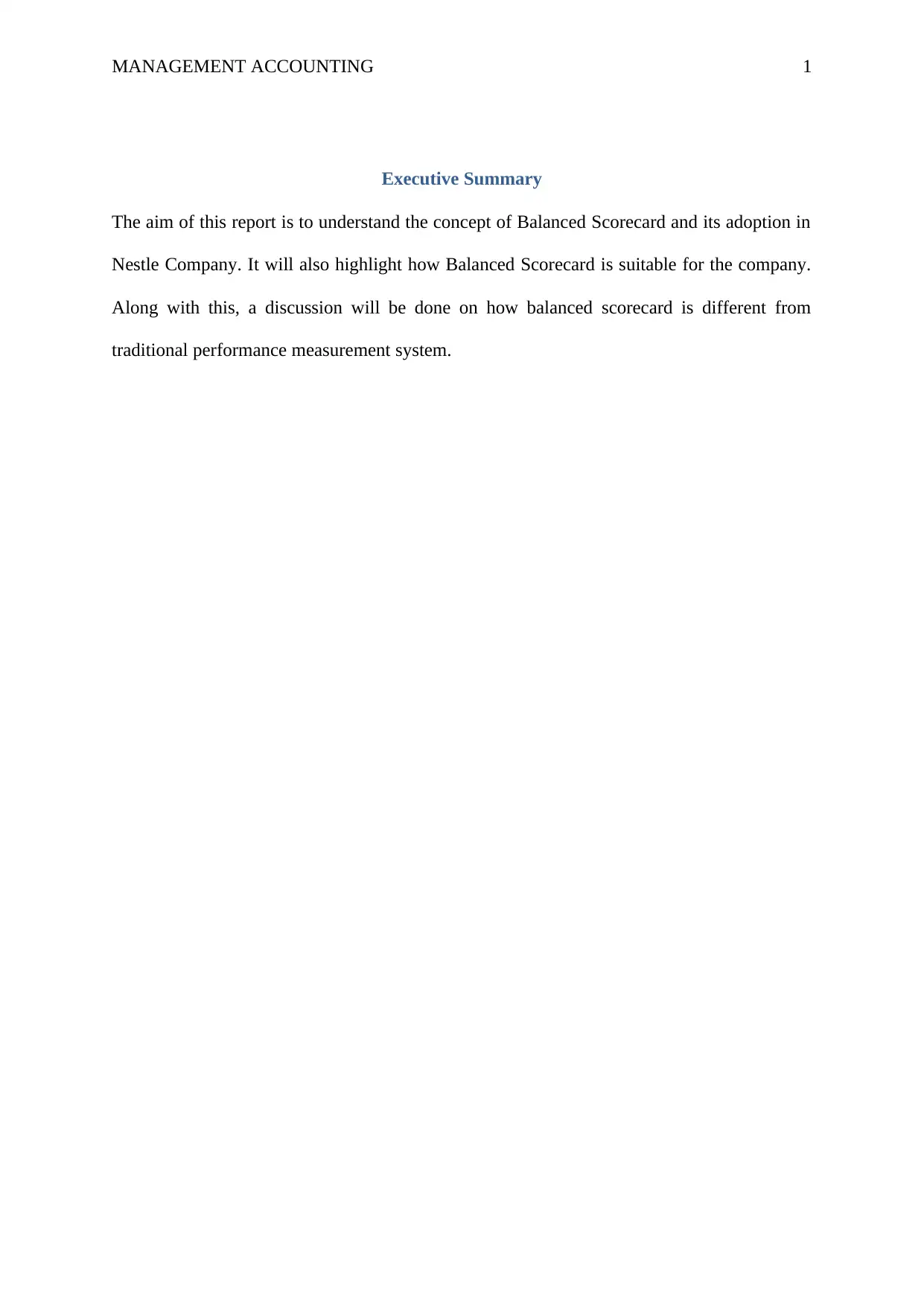
MANAGEMENT ACCOUNTING 1
Executive Summary
The aim of this report is to understand the concept of Balanced Scorecard and its adoption in
Nestle Company. It will also highlight how Balanced Scorecard is suitable for the company.
Along with this, a discussion will be done on how balanced scorecard is different from
traditional performance measurement system.
Executive Summary
The aim of this report is to understand the concept of Balanced Scorecard and its adoption in
Nestle Company. It will also highlight how Balanced Scorecard is suitable for the company.
Along with this, a discussion will be done on how balanced scorecard is different from
traditional performance measurement system.

MANAGEMENT ACCOUNTING 2
Table of Contents
Executive Summary...................................................................................................................1
Introduction................................................................................................................................3
Overview of Nestle................................................................................................................3
Balanced Scorecard................................................................................................................5
The Four perspectives of balanced scorecard....................................................................5
Features of Balanced Scorecard.........................................................................................6
Balanced Scorecard for Nestle Company..........................................................................8
Ways by which Balanced Scorecard is different from Traditional Performance
Measurement System.............................................................................................................8
Suitability of Balanced Scorecard for Nestle.......................................................................11
Covers Operational Activities..........................................................................................11
Allows Performance Analysis..........................................................................................12
Refine Measures and Metrics...........................................................................................12
Communicates Vision and Mission.................................................................................12
Clarifies Strategic Objectives...........................................................................................12
Conclusion................................................................................................................................13
References................................................................................................................................14
Table of Contents
Executive Summary...................................................................................................................1
Introduction................................................................................................................................3
Overview of Nestle................................................................................................................3
Balanced Scorecard................................................................................................................5
The Four perspectives of balanced scorecard....................................................................5
Features of Balanced Scorecard.........................................................................................6
Balanced Scorecard for Nestle Company..........................................................................8
Ways by which Balanced Scorecard is different from Traditional Performance
Measurement System.............................................................................................................8
Suitability of Balanced Scorecard for Nestle.......................................................................11
Covers Operational Activities..........................................................................................11
Allows Performance Analysis..........................................................................................12
Refine Measures and Metrics...........................................................................................12
Communicates Vision and Mission.................................................................................12
Clarifies Strategic Objectives...........................................................................................12
Conclusion................................................................................................................................13
References................................................................................................................................14
⊘ This is a preview!⊘
Do you want full access?
Subscribe today to unlock all pages.

Trusted by 1+ million students worldwide
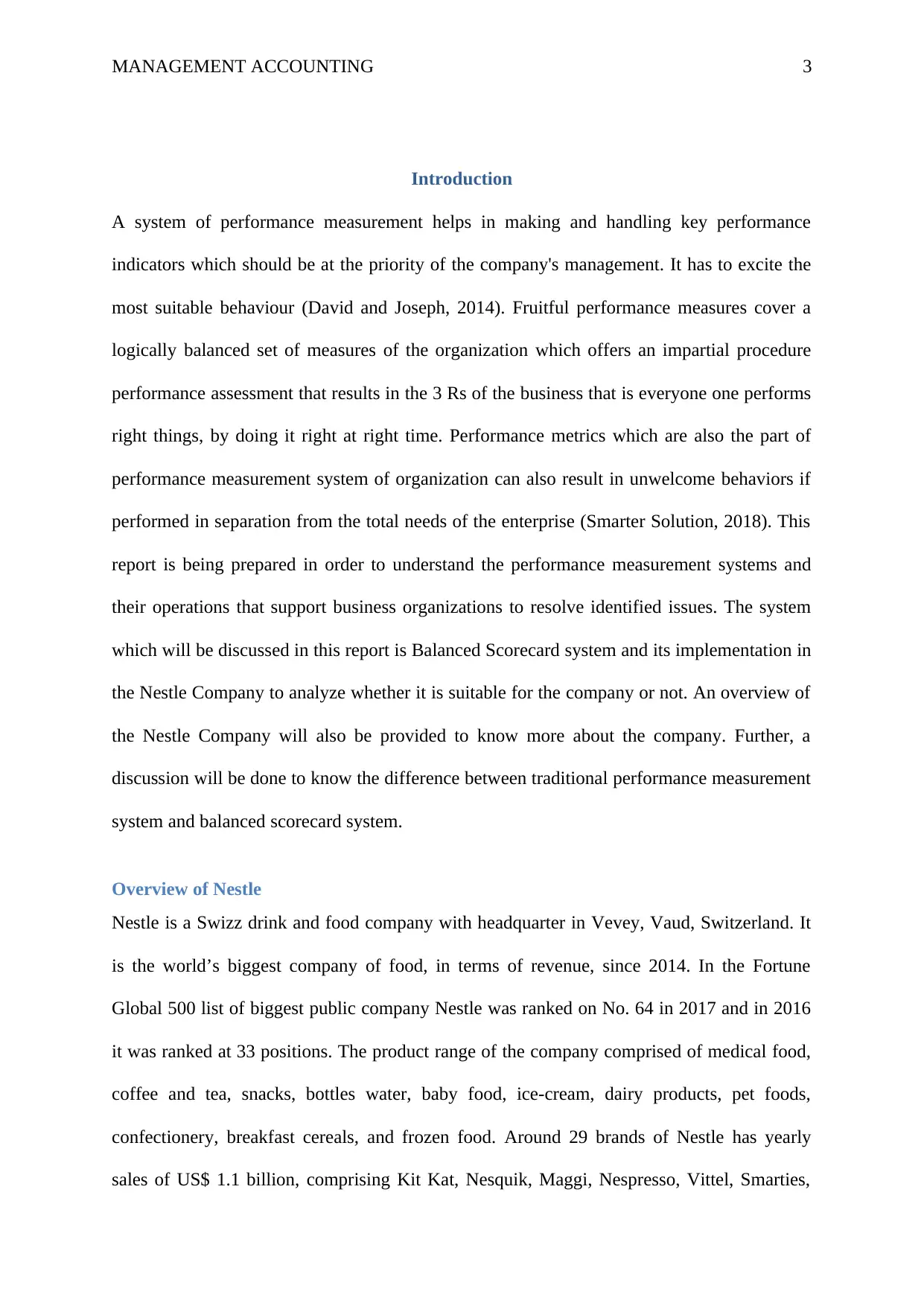
MANAGEMENT ACCOUNTING 3
Introduction
A system of performance measurement helps in making and handling key performance
indicators which should be at the priority of the company's management. It has to excite the
most suitable behaviour (David and Joseph, 2014). Fruitful performance measures cover a
logically balanced set of measures of the organization which offers an impartial procedure
performance assessment that results in the 3 Rs of the business that is everyone one performs
right things, by doing it right at right time. Performance metrics which are also the part of
performance measurement system of organization can also result in unwelcome behaviors if
performed in separation from the total needs of the enterprise (Smarter Solution, 2018). This
report is being prepared in order to understand the performance measurement systems and
their operations that support business organizations to resolve identified issues. The system
which will be discussed in this report is Balanced Scorecard system and its implementation in
the Nestle Company to analyze whether it is suitable for the company or not. An overview of
the Nestle Company will also be provided to know more about the company. Further, a
discussion will be done to know the difference between traditional performance measurement
system and balanced scorecard system.
Overview of Nestle
Nestle is a Swizz drink and food company with headquarter in Vevey, Vaud, Switzerland. It
is the world’s biggest company of food, in terms of revenue, since 2014. In the Fortune
Global 500 list of biggest public company Nestle was ranked on No. 64 in 2017 and in 2016
it was ranked at 33 positions. The product range of the company comprised of medical food,
coffee and tea, snacks, bottles water, baby food, ice-cream, dairy products, pet foods,
confectionery, breakfast cereals, and frozen food. Around 29 brands of Nestle has yearly
sales of US$ 1.1 billion, comprising Kit Kat, Nesquik, Maggi, Nespresso, Vittel, Smarties,
Introduction
A system of performance measurement helps in making and handling key performance
indicators which should be at the priority of the company's management. It has to excite the
most suitable behaviour (David and Joseph, 2014). Fruitful performance measures cover a
logically balanced set of measures of the organization which offers an impartial procedure
performance assessment that results in the 3 Rs of the business that is everyone one performs
right things, by doing it right at right time. Performance metrics which are also the part of
performance measurement system of organization can also result in unwelcome behaviors if
performed in separation from the total needs of the enterprise (Smarter Solution, 2018). This
report is being prepared in order to understand the performance measurement systems and
their operations that support business organizations to resolve identified issues. The system
which will be discussed in this report is Balanced Scorecard system and its implementation in
the Nestle Company to analyze whether it is suitable for the company or not. An overview of
the Nestle Company will also be provided to know more about the company. Further, a
discussion will be done to know the difference between traditional performance measurement
system and balanced scorecard system.
Overview of Nestle
Nestle is a Swizz drink and food company with headquarter in Vevey, Vaud, Switzerland. It
is the world’s biggest company of food, in terms of revenue, since 2014. In the Fortune
Global 500 list of biggest public company Nestle was ranked on No. 64 in 2017 and in 2016
it was ranked at 33 positions. The product range of the company comprised of medical food,
coffee and tea, snacks, bottles water, baby food, ice-cream, dairy products, pet foods,
confectionery, breakfast cereals, and frozen food. Around 29 brands of Nestle has yearly
sales of US$ 1.1 billion, comprising Kit Kat, Nesquik, Maggi, Nespresso, Vittel, Smarties,
Paraphrase This Document
Need a fresh take? Get an instant paraphrase of this document with our AI Paraphraser
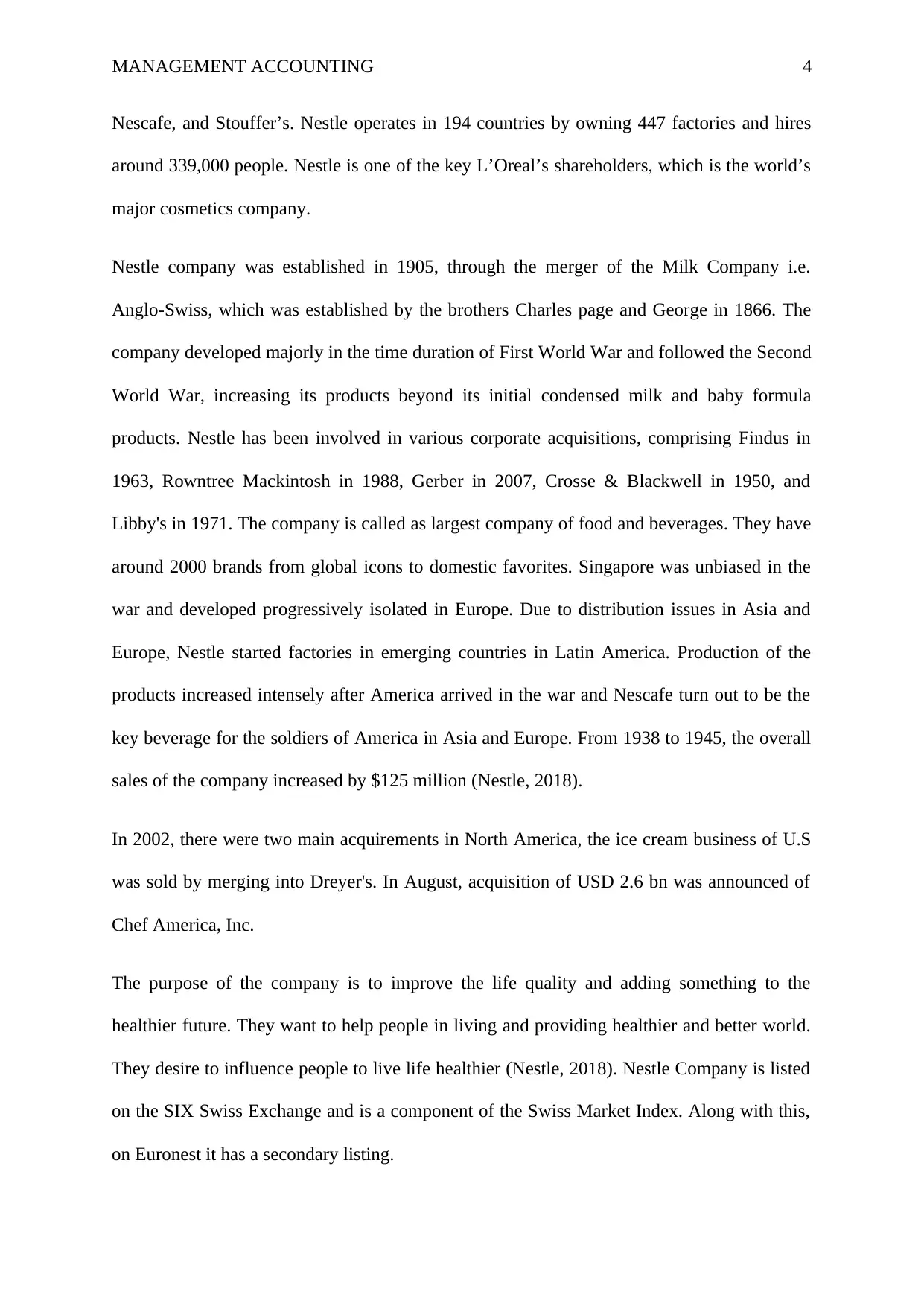
MANAGEMENT ACCOUNTING 4
Nescafe, and Stouffer’s. Nestle operates in 194 countries by owning 447 factories and hires
around 339,000 people. Nestle is one of the key L’Oreal’s shareholders, which is the world’s
major cosmetics company.
Nestle company was established in 1905, through the merger of the Milk Company i.e.
Anglo-Swiss, which was established by the brothers Charles page and George in 1866. The
company developed majorly in the time duration of First World War and followed the Second
World War, increasing its products beyond its initial condensed milk and baby formula
products. Nestle has been involved in various corporate acquisitions, comprising Findus in
1963, Rowntree Mackintosh in 1988, Gerber in 2007, Crosse & Blackwell in 1950, and
Libby's in 1971. The company is called as largest company of food and beverages. They have
around 2000 brands from global icons to domestic favorites. Singapore was unbiased in the
war and developed progressively isolated in Europe. Due to distribution issues in Asia and
Europe, Nestle started factories in emerging countries in Latin America. Production of the
products increased intensely after America arrived in the war and Nescafe turn out to be the
key beverage for the soldiers of America in Asia and Europe. From 1938 to 1945, the overall
sales of the company increased by $125 million (Nestle, 2018).
In 2002, there were two main acquirements in North America, the ice cream business of U.S
was sold by merging into Dreyer's. In August, acquisition of USD 2.6 bn was announced of
Chef America, Inc.
The purpose of the company is to improve the life quality and adding something to the
healthier future. They want to help people in living and providing healthier and better world.
They desire to influence people to live life healthier (Nestle, 2018). Nestle Company is listed
on the SIX Swiss Exchange and is a component of the Swiss Market Index. Along with this,
on Euronest it has a secondary listing.
Nescafe, and Stouffer’s. Nestle operates in 194 countries by owning 447 factories and hires
around 339,000 people. Nestle is one of the key L’Oreal’s shareholders, which is the world’s
major cosmetics company.
Nestle company was established in 1905, through the merger of the Milk Company i.e.
Anglo-Swiss, which was established by the brothers Charles page and George in 1866. The
company developed majorly in the time duration of First World War and followed the Second
World War, increasing its products beyond its initial condensed milk and baby formula
products. Nestle has been involved in various corporate acquisitions, comprising Findus in
1963, Rowntree Mackintosh in 1988, Gerber in 2007, Crosse & Blackwell in 1950, and
Libby's in 1971. The company is called as largest company of food and beverages. They have
around 2000 brands from global icons to domestic favorites. Singapore was unbiased in the
war and developed progressively isolated in Europe. Due to distribution issues in Asia and
Europe, Nestle started factories in emerging countries in Latin America. Production of the
products increased intensely after America arrived in the war and Nescafe turn out to be the
key beverage for the soldiers of America in Asia and Europe. From 1938 to 1945, the overall
sales of the company increased by $125 million (Nestle, 2018).
In 2002, there were two main acquirements in North America, the ice cream business of U.S
was sold by merging into Dreyer's. In August, acquisition of USD 2.6 bn was announced of
Chef America, Inc.
The purpose of the company is to improve the life quality and adding something to the
healthier future. They want to help people in living and providing healthier and better world.
They desire to influence people to live life healthier (Nestle, 2018). Nestle Company is listed
on the SIX Swiss Exchange and is a component of the Swiss Market Index. Along with this,
on Euronest it has a secondary listing.
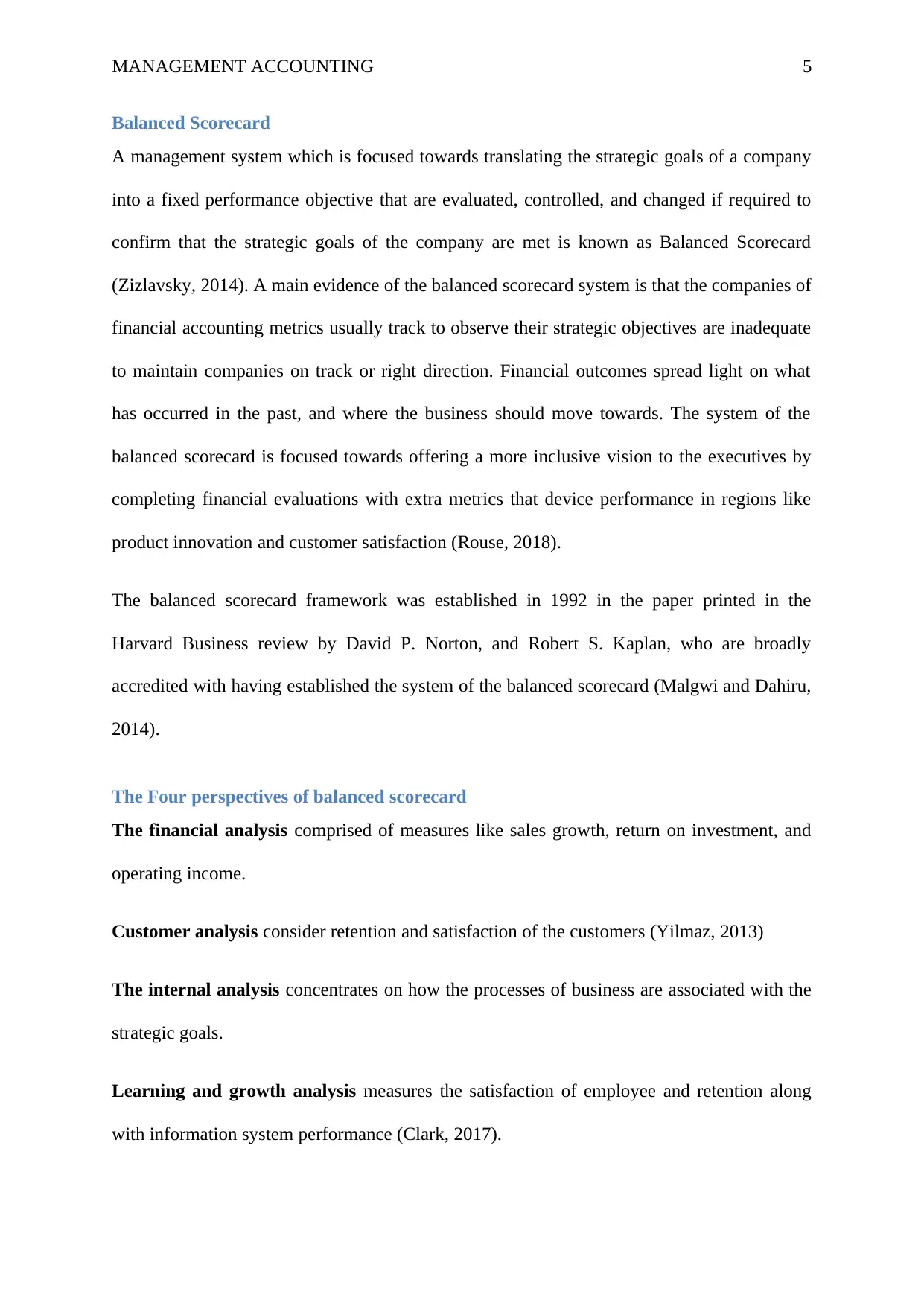
MANAGEMENT ACCOUNTING 5
Balanced Scorecard
A management system which is focused towards translating the strategic goals of a company
into a fixed performance objective that are evaluated, controlled, and changed if required to
confirm that the strategic goals of the company are met is known as Balanced Scorecard
(Zizlavsky, 2014). A main evidence of the balanced scorecard system is that the companies of
financial accounting metrics usually track to observe their strategic objectives are inadequate
to maintain companies on track or right direction. Financial outcomes spread light on what
has occurred in the past, and where the business should move towards. The system of the
balanced scorecard is focused towards offering a more inclusive vision to the executives by
completing financial evaluations with extra metrics that device performance in regions like
product innovation and customer satisfaction (Rouse, 2018).
The balanced scorecard framework was established in 1992 in the paper printed in the
Harvard Business review by David P. Norton, and Robert S. Kaplan, who are broadly
accredited with having established the system of the balanced scorecard (Malgwi and Dahiru,
2014).
The Four perspectives of balanced scorecard
The financial analysis comprised of measures like sales growth, return on investment, and
operating income.
Customer analysis consider retention and satisfaction of the customers (Yilmaz, 2013)
The internal analysis concentrates on how the processes of business are associated with the
strategic goals.
Learning and growth analysis measures the satisfaction of employee and retention along
with information system performance (Clark, 2017).
Balanced Scorecard
A management system which is focused towards translating the strategic goals of a company
into a fixed performance objective that are evaluated, controlled, and changed if required to
confirm that the strategic goals of the company are met is known as Balanced Scorecard
(Zizlavsky, 2014). A main evidence of the balanced scorecard system is that the companies of
financial accounting metrics usually track to observe their strategic objectives are inadequate
to maintain companies on track or right direction. Financial outcomes spread light on what
has occurred in the past, and where the business should move towards. The system of the
balanced scorecard is focused towards offering a more inclusive vision to the executives by
completing financial evaluations with extra metrics that device performance in regions like
product innovation and customer satisfaction (Rouse, 2018).
The balanced scorecard framework was established in 1992 in the paper printed in the
Harvard Business review by David P. Norton, and Robert S. Kaplan, who are broadly
accredited with having established the system of the balanced scorecard (Malgwi and Dahiru,
2014).
The Four perspectives of balanced scorecard
The financial analysis comprised of measures like sales growth, return on investment, and
operating income.
Customer analysis consider retention and satisfaction of the customers (Yilmaz, 2013)
The internal analysis concentrates on how the processes of business are associated with the
strategic goals.
Learning and growth analysis measures the satisfaction of employee and retention along
with information system performance (Clark, 2017).
⊘ This is a preview!⊘
Do you want full access?
Subscribe today to unlock all pages.

Trusted by 1+ million students worldwide
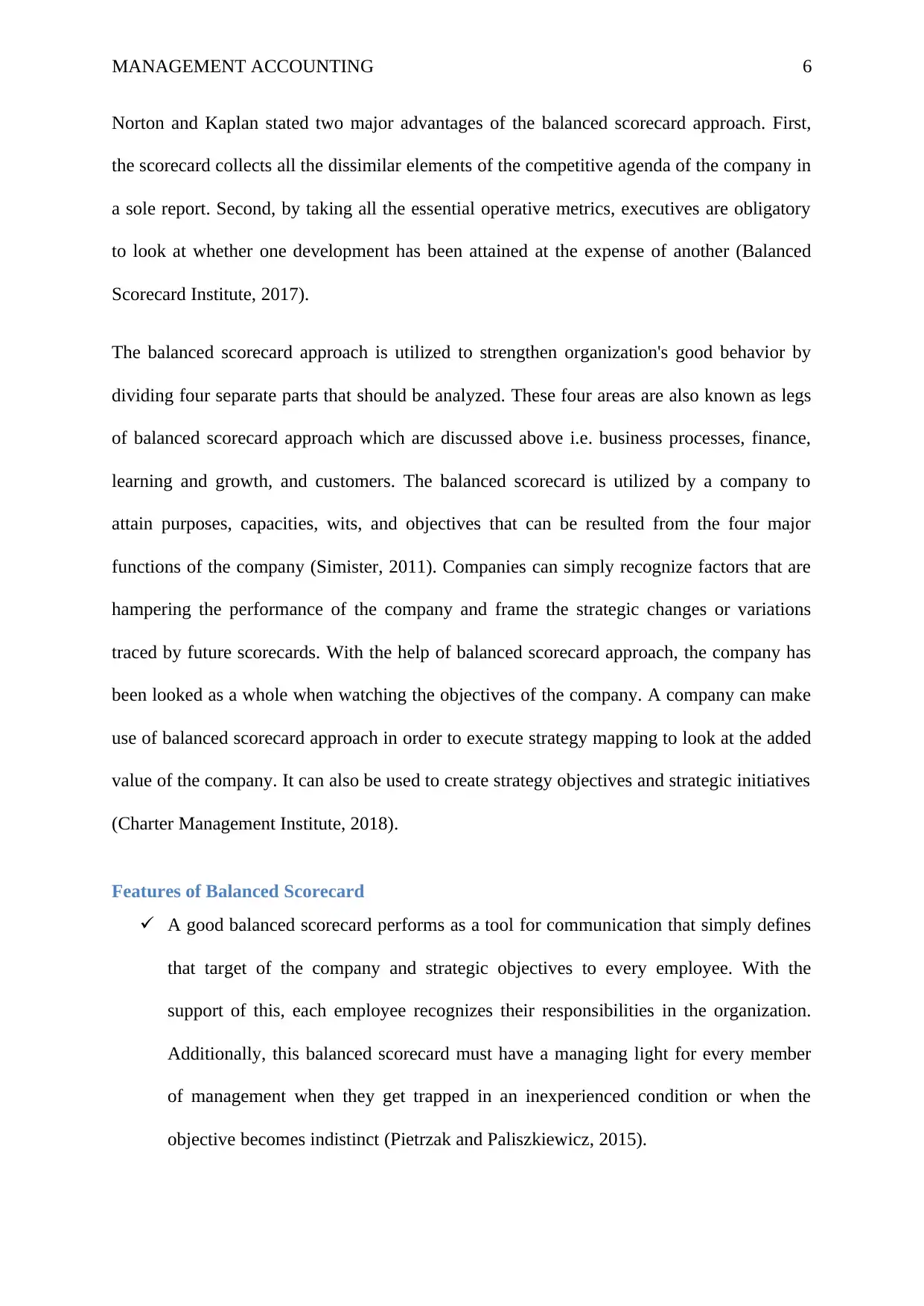
MANAGEMENT ACCOUNTING 6
Norton and Kaplan stated two major advantages of the balanced scorecard approach. First,
the scorecard collects all the dissimilar elements of the competitive agenda of the company in
a sole report. Second, by taking all the essential operative metrics, executives are obligatory
to look at whether one development has been attained at the expense of another (Balanced
Scorecard Institute, 2017).
The balanced scorecard approach is utilized to strengthen organization's good behavior by
dividing four separate parts that should be analyzed. These four areas are also known as legs
of balanced scorecard approach which are discussed above i.e. business processes, finance,
learning and growth, and customers. The balanced scorecard is utilized by a company to
attain purposes, capacities, wits, and objectives that can be resulted from the four major
functions of the company (Simister, 2011). Companies can simply recognize factors that are
hampering the performance of the company and frame the strategic changes or variations
traced by future scorecards. With the help of balanced scorecard approach, the company has
been looked as a whole when watching the objectives of the company. A company can make
use of balanced scorecard approach in order to execute strategy mapping to look at the added
value of the company. It can also be used to create strategy objectives and strategic initiatives
(Charter Management Institute, 2018).
Features of Balanced Scorecard
A good balanced scorecard performs as a tool for communication that simply defines
that target of the company and strategic objectives to every employee. With the
support of this, each employee recognizes their responsibilities in the organization.
Additionally, this balanced scorecard must have a managing light for every member
of management when they get trapped in an inexperienced condition or when the
objective becomes indistinct (Pietrzak and Paliszkiewicz, 2015).
Norton and Kaplan stated two major advantages of the balanced scorecard approach. First,
the scorecard collects all the dissimilar elements of the competitive agenda of the company in
a sole report. Second, by taking all the essential operative metrics, executives are obligatory
to look at whether one development has been attained at the expense of another (Balanced
Scorecard Institute, 2017).
The balanced scorecard approach is utilized to strengthen organization's good behavior by
dividing four separate parts that should be analyzed. These four areas are also known as legs
of balanced scorecard approach which are discussed above i.e. business processes, finance,
learning and growth, and customers. The balanced scorecard is utilized by a company to
attain purposes, capacities, wits, and objectives that can be resulted from the four major
functions of the company (Simister, 2011). Companies can simply recognize factors that are
hampering the performance of the company and frame the strategic changes or variations
traced by future scorecards. With the help of balanced scorecard approach, the company has
been looked as a whole when watching the objectives of the company. A company can make
use of balanced scorecard approach in order to execute strategy mapping to look at the added
value of the company. It can also be used to create strategy objectives and strategic initiatives
(Charter Management Institute, 2018).
Features of Balanced Scorecard
A good balanced scorecard performs as a tool for communication that simply defines
that target of the company and strategic objectives to every employee. With the
support of this, each employee recognizes their responsibilities in the organization.
Additionally, this balanced scorecard must have a managing light for every member
of management when they get trapped in an inexperienced condition or when the
objective becomes indistinct (Pietrzak and Paliszkiewicz, 2015).
Paraphrase This Document
Need a fresh take? Get an instant paraphrase of this document with our AI Paraphraser
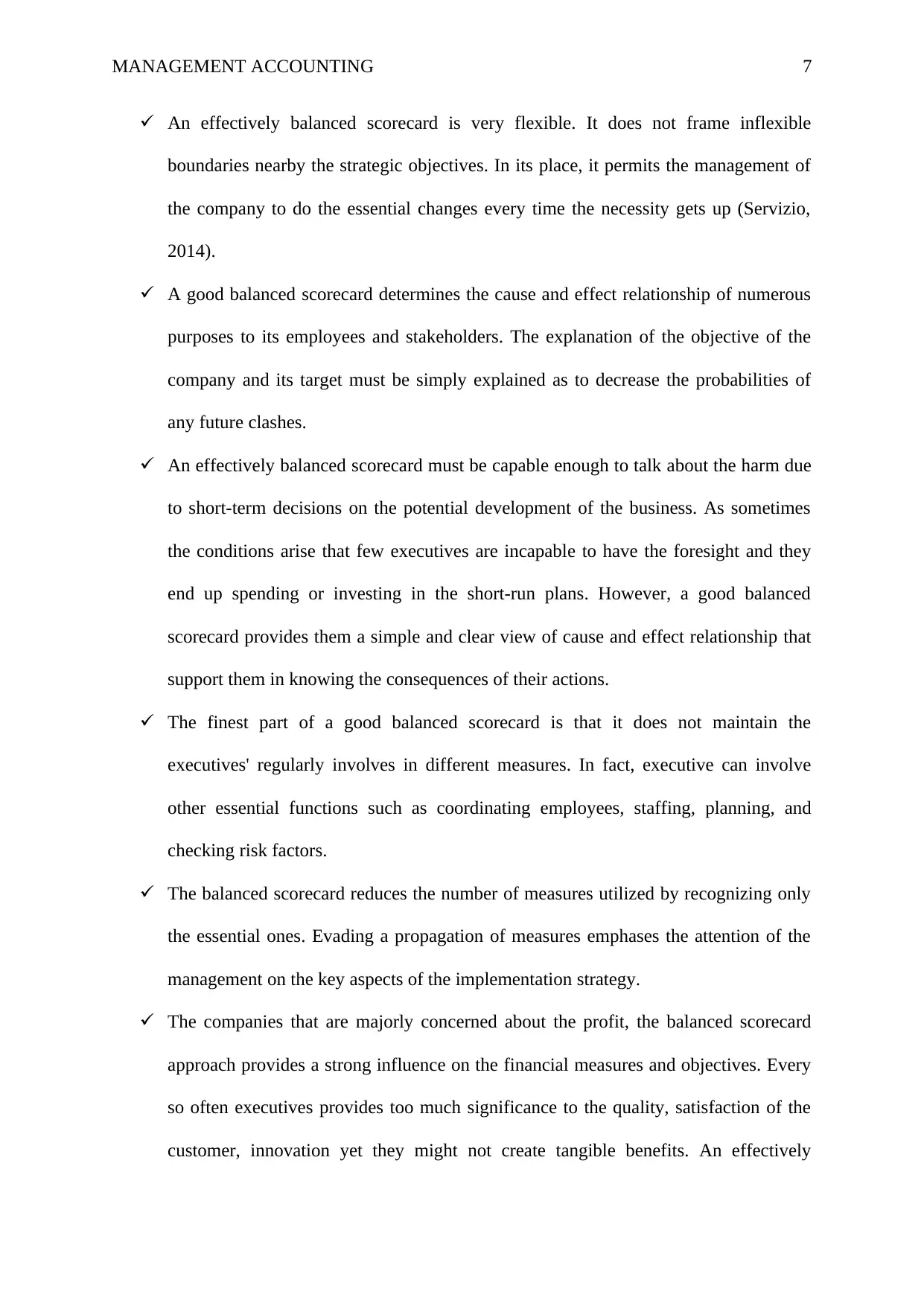
MANAGEMENT ACCOUNTING 7
An effectively balanced scorecard is very flexible. It does not frame inflexible
boundaries nearby the strategic objectives. In its place, it permits the management of
the company to do the essential changes every time the necessity gets up (Servizio,
2014).
A good balanced scorecard determines the cause and effect relationship of numerous
purposes to its employees and stakeholders. The explanation of the objective of the
company and its target must be simply explained as to decrease the probabilities of
any future clashes.
An effectively balanced scorecard must be capable enough to talk about the harm due
to short-term decisions on the potential development of the business. As sometimes
the conditions arise that few executives are incapable to have the foresight and they
end up spending or investing in the short-run plans. However, a good balanced
scorecard provides them a simple and clear view of cause and effect relationship that
support them in knowing the consequences of their actions.
The finest part of a good balanced scorecard is that it does not maintain the
executives' regularly involves in different measures. In fact, executive can involve
other essential functions such as coordinating employees, staffing, planning, and
checking risk factors.
The balanced scorecard reduces the number of measures utilized by recognizing only
the essential ones. Evading a propagation of measures emphases the attention of the
management on the key aspects of the implementation strategy.
The companies that are majorly concerned about the profit, the balanced scorecard
approach provides a strong influence on the financial measures and objectives. Every
so often executives provides too much significance to the quality, satisfaction of the
customer, innovation yet they might not create tangible benefits. An effectively
An effectively balanced scorecard is very flexible. It does not frame inflexible
boundaries nearby the strategic objectives. In its place, it permits the management of
the company to do the essential changes every time the necessity gets up (Servizio,
2014).
A good balanced scorecard determines the cause and effect relationship of numerous
purposes to its employees and stakeholders. The explanation of the objective of the
company and its target must be simply explained as to decrease the probabilities of
any future clashes.
An effectively balanced scorecard must be capable enough to talk about the harm due
to short-term decisions on the potential development of the business. As sometimes
the conditions arise that few executives are incapable to have the foresight and they
end up spending or investing in the short-run plans. However, a good balanced
scorecard provides them a simple and clear view of cause and effect relationship that
support them in knowing the consequences of their actions.
The finest part of a good balanced scorecard is that it does not maintain the
executives' regularly involves in different measures. In fact, executive can involve
other essential functions such as coordinating employees, staffing, planning, and
checking risk factors.
The balanced scorecard reduces the number of measures utilized by recognizing only
the essential ones. Evading a propagation of measures emphases the attention of the
management on the key aspects of the implementation strategy.
The companies that are majorly concerned about the profit, the balanced scorecard
approach provides a strong influence on the financial measures and objectives. Every
so often executives provides too much significance to the quality, satisfaction of the
customer, innovation yet they might not create tangible benefits. An effectively

MANAGEMENT ACCOUNTING 8
balanced scorecard observes non-financial measures as a major portion of the
programme or strategy to attain and enhance future financial performance. When non-
financial and financial measures of performance are correctly related in the balanced
scorecards, several non-financial measures assist as foremost pointers of upcoming
financial performance (Agarwal, 2018).
Balanced Scorecard for Nestle Company
Perspectives Objectives Goals Measurement
Customer
Perspective
Make use of
qualitative raw
material and offering
online products
Improvement of
quality and Easy
accessibility of the
product
Increased revenue
and good health of
the customers
Internal business
perspective
Payment
convenience
Increasing sales Payment methods
Learning and
Growth
Employee efficiency
and retention
Improving efficiency
of employees and
their productivity
Employee’s
satisfaction
Financial
Perspective
Sales leadership in
dairy products and
financial stability
Higher returns and
cost-cutting
Operating margin
ratio and return on
investment
Ways by which Balanced Scorecard is different from Traditional Performance
Measurement System
Growing competition, altering external demand along with responsibilities is compelling the
companies to inspect and develop their management systems and strategies. Today, the
balanced scorecard observes non-financial measures as a major portion of the
programme or strategy to attain and enhance future financial performance. When non-
financial and financial measures of performance are correctly related in the balanced
scorecards, several non-financial measures assist as foremost pointers of upcoming
financial performance (Agarwal, 2018).
Balanced Scorecard for Nestle Company
Perspectives Objectives Goals Measurement
Customer
Perspective
Make use of
qualitative raw
material and offering
online products
Improvement of
quality and Easy
accessibility of the
product
Increased revenue
and good health of
the customers
Internal business
perspective
Payment
convenience
Increasing sales Payment methods
Learning and
Growth
Employee efficiency
and retention
Improving efficiency
of employees and
their productivity
Employee’s
satisfaction
Financial
Perspective
Sales leadership in
dairy products and
financial stability
Higher returns and
cost-cutting
Operating margin
ratio and return on
investment
Ways by which Balanced Scorecard is different from Traditional Performance
Measurement System
Growing competition, altering external demand along with responsibilities is compelling the
companies to inspect and develop their management systems and strategies. Today, the
⊘ This is a preview!⊘
Do you want full access?
Subscribe today to unlock all pages.

Trusted by 1+ million students worldwide

MANAGEMENT ACCOUNTING 9
environment in which businesses are being operated is very dynamic and achievement is
dependent on meeting the altering needs of every stakeholder, a company cannot create a
self-centered system of performance measurement. Organizations make use of traditional
performance measurement system which does not provide an overall evaluation. Therefore,
diverse systems performance measurement i.e. balanced scorecard was developed to overawe
the faults of the traditional systems of performance measurement (Striteska and Spickova,
2012).
The system of traditional performance measurement concentrate only on the financial
measures. The reports of the 1980s reflect that the holistic financial data is not sufficient to
gratify the Performance Measurement in the fresh economy due to the augmented
organization's complexities and the marketplaces in which businesses compete. Because the
financial statements and reports are less revealing of shareholder’s value. As reflected by
Cumby and Conrod (2001), justifiable shareholder value is instead determined by the factors
which are non-financial, like the satisfaction of employee, innovations of the organization,
the loyalty of the customer, and internal processes. According to the standard, only 10-15%
of the market value is covered by traditional accounting measures (Striteska and Spickova,
2012). Therefore, today it can be seen that there is increasing influence on the non-financial
measures that are forward-looking.
The balanced scorecard is one of the forward-looking performance measurement systems
which are different from traditional measurement system because it not only considers the
financial measures but also non-financial measures. It is a tool used to explain, execute and
handling strategy at every level in the company. The Balanced Scorecard system guides the
company in creating a better and improved performance measurement system than one
exclusively reliant on financial measures such as Traditional performance measurement.
environment in which businesses are being operated is very dynamic and achievement is
dependent on meeting the altering needs of every stakeholder, a company cannot create a
self-centered system of performance measurement. Organizations make use of traditional
performance measurement system which does not provide an overall evaluation. Therefore,
diverse systems performance measurement i.e. balanced scorecard was developed to overawe
the faults of the traditional systems of performance measurement (Striteska and Spickova,
2012).
The system of traditional performance measurement concentrate only on the financial
measures. The reports of the 1980s reflect that the holistic financial data is not sufficient to
gratify the Performance Measurement in the fresh economy due to the augmented
organization's complexities and the marketplaces in which businesses compete. Because the
financial statements and reports are less revealing of shareholder’s value. As reflected by
Cumby and Conrod (2001), justifiable shareholder value is instead determined by the factors
which are non-financial, like the satisfaction of employee, innovations of the organization,
the loyalty of the customer, and internal processes. According to the standard, only 10-15%
of the market value is covered by traditional accounting measures (Striteska and Spickova,
2012). Therefore, today it can be seen that there is increasing influence on the non-financial
measures that are forward-looking.
The balanced scorecard is one of the forward-looking performance measurement systems
which are different from traditional measurement system because it not only considers the
financial measures but also non-financial measures. It is a tool used to explain, execute and
handling strategy at every level in the company. The Balanced Scorecard system guides the
company in creating a better and improved performance measurement system than one
exclusively reliant on financial measures such as Traditional performance measurement.
Paraphrase This Document
Need a fresh take? Get an instant paraphrase of this document with our AI Paraphraser
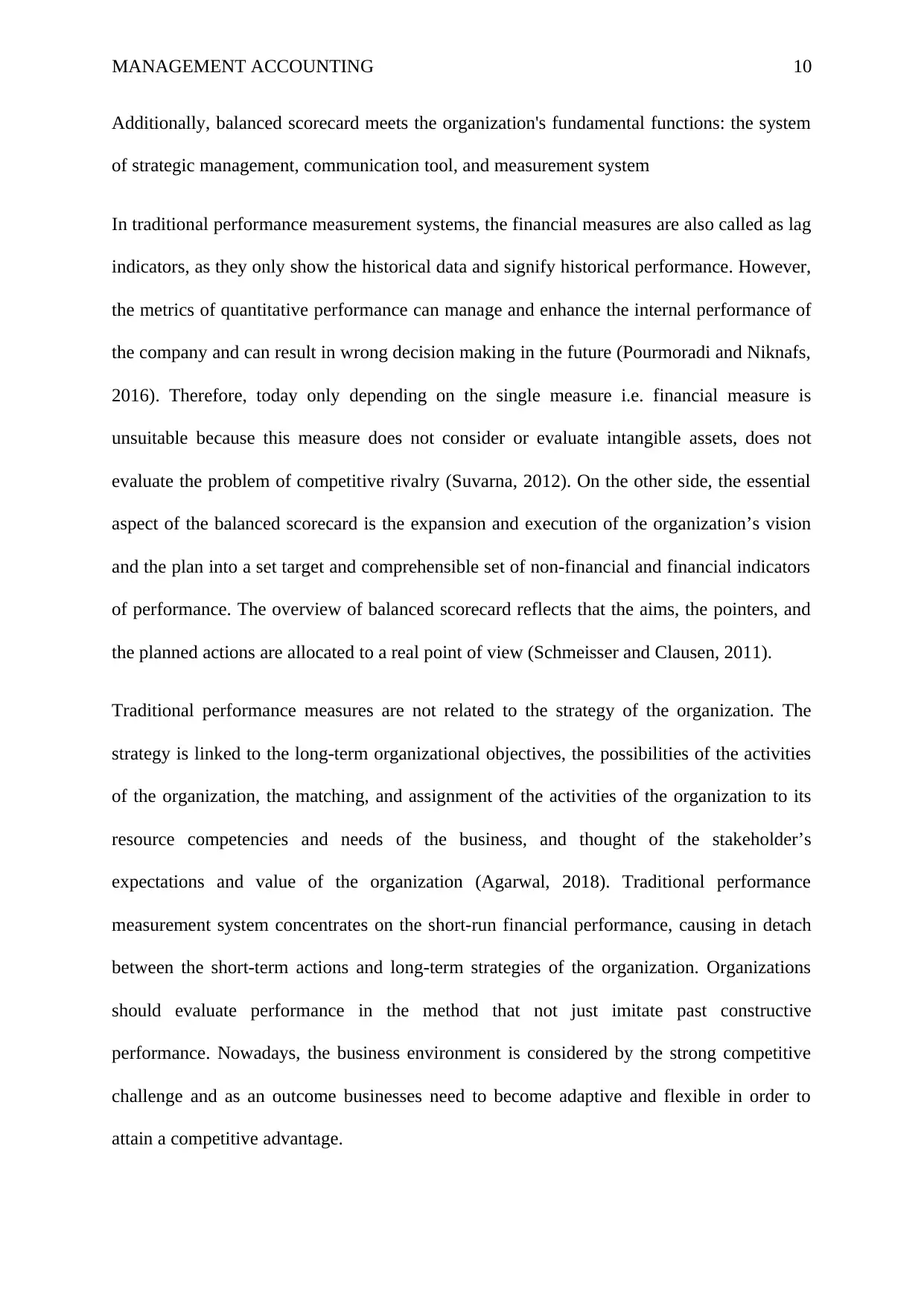
MANAGEMENT ACCOUNTING 10
Additionally, balanced scorecard meets the organization's fundamental functions: the system
of strategic management, communication tool, and measurement system
In traditional performance measurement systems, the financial measures are also called as lag
indicators, as they only show the historical data and signify historical performance. However,
the metrics of quantitative performance can manage and enhance the internal performance of
the company and can result in wrong decision making in the future (Pourmoradi and Niknafs,
2016). Therefore, today only depending on the single measure i.e. financial measure is
unsuitable because this measure does not consider or evaluate intangible assets, does not
evaluate the problem of competitive rivalry (Suvarna, 2012). On the other side, the essential
aspect of the balanced scorecard is the expansion and execution of the organization’s vision
and the plan into a set target and comprehensible set of non-financial and financial indicators
of performance. The overview of balanced scorecard reflects that the aims, the pointers, and
the planned actions are allocated to a real point of view (Schmeisser and Clausen, 2011).
Traditional performance measures are not related to the strategy of the organization. The
strategy is linked to the long-term organizational objectives, the possibilities of the activities
of the organization, the matching, and assignment of the activities of the organization to its
resource competencies and needs of the business, and thought of the stakeholder’s
expectations and value of the organization (Agarwal, 2018). Traditional performance
measurement system concentrates on the short-run financial performance, causing in detach
between the short-term actions and long-term strategies of the organization. Organizations
should evaluate performance in the method that not just imitate past constructive
performance. Nowadays, the business environment is considered by the strong competitive
challenge and as an outcome businesses need to become adaptive and flexible in order to
attain a competitive advantage.
Additionally, balanced scorecard meets the organization's fundamental functions: the system
of strategic management, communication tool, and measurement system
In traditional performance measurement systems, the financial measures are also called as lag
indicators, as they only show the historical data and signify historical performance. However,
the metrics of quantitative performance can manage and enhance the internal performance of
the company and can result in wrong decision making in the future (Pourmoradi and Niknafs,
2016). Therefore, today only depending on the single measure i.e. financial measure is
unsuitable because this measure does not consider or evaluate intangible assets, does not
evaluate the problem of competitive rivalry (Suvarna, 2012). On the other side, the essential
aspect of the balanced scorecard is the expansion and execution of the organization’s vision
and the plan into a set target and comprehensible set of non-financial and financial indicators
of performance. The overview of balanced scorecard reflects that the aims, the pointers, and
the planned actions are allocated to a real point of view (Schmeisser and Clausen, 2011).
Traditional performance measures are not related to the strategy of the organization. The
strategy is linked to the long-term organizational objectives, the possibilities of the activities
of the organization, the matching, and assignment of the activities of the organization to its
resource competencies and needs of the business, and thought of the stakeholder’s
expectations and value of the organization (Agarwal, 2018). Traditional performance
measurement system concentrates on the short-run financial performance, causing in detach
between the short-term actions and long-term strategies of the organization. Organizations
should evaluate performance in the method that not just imitate past constructive
performance. Nowadays, the business environment is considered by the strong competitive
challenge and as an outcome businesses need to become adaptive and flexible in order to
attain a competitive advantage.
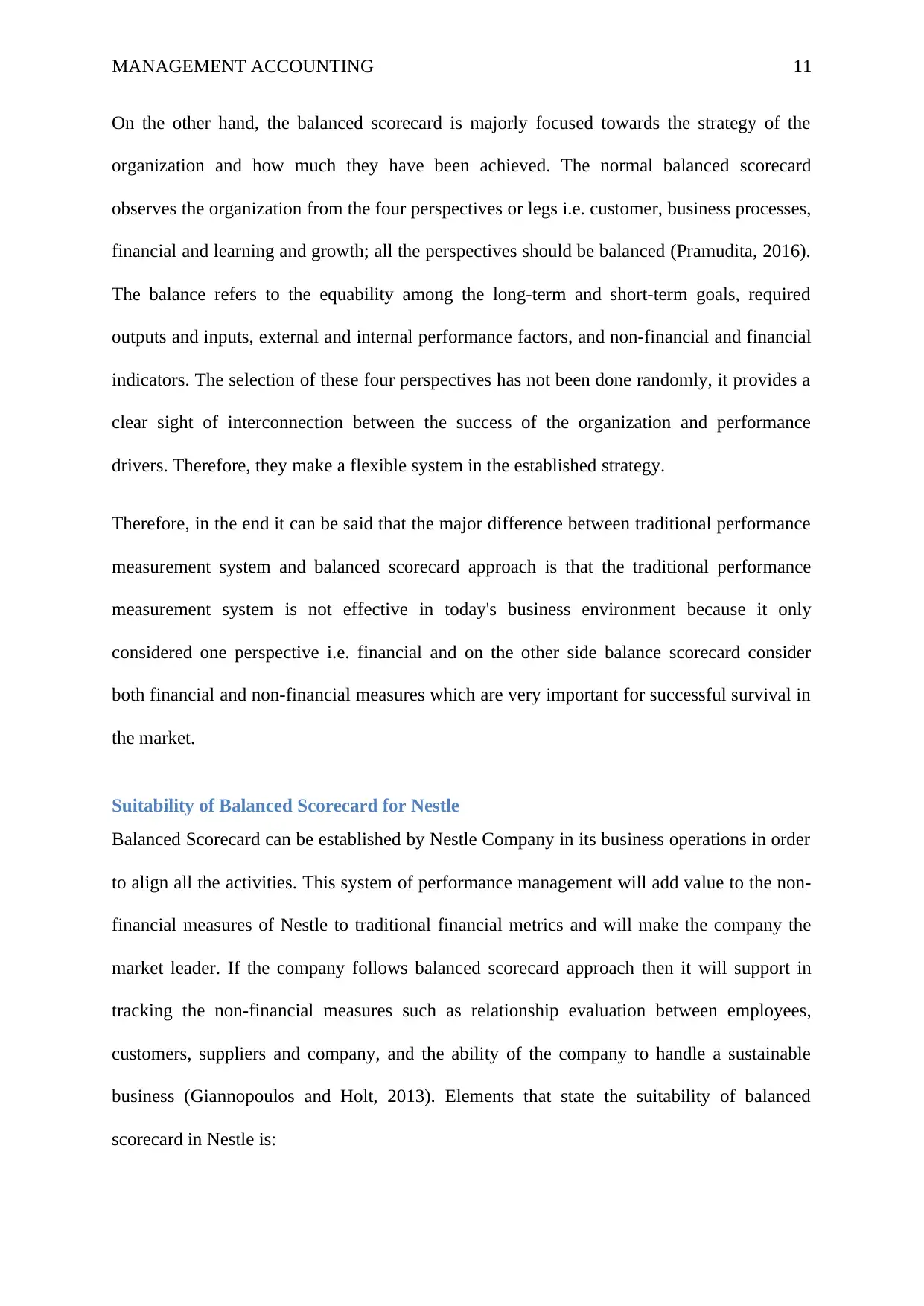
MANAGEMENT ACCOUNTING 11
On the other hand, the balanced scorecard is majorly focused towards the strategy of the
organization and how much they have been achieved. The normal balanced scorecard
observes the organization from the four perspectives or legs i.e. customer, business processes,
financial and learning and growth; all the perspectives should be balanced (Pramudita, 2016).
The balance refers to the equability among the long-term and short-term goals, required
outputs and inputs, external and internal performance factors, and non-financial and financial
indicators. The selection of these four perspectives has not been done randomly, it provides a
clear sight of interconnection between the success of the organization and performance
drivers. Therefore, they make a flexible system in the established strategy.
Therefore, in the end it can be said that the major difference between traditional performance
measurement system and balanced scorecard approach is that the traditional performance
measurement system is not effective in today's business environment because it only
considered one perspective i.e. financial and on the other side balance scorecard consider
both financial and non-financial measures which are very important for successful survival in
the market.
Suitability of Balanced Scorecard for Nestle
Balanced Scorecard can be established by Nestle Company in its business operations in order
to align all the activities. This system of performance management will add value to the non-
financial measures of Nestle to traditional financial metrics and will make the company the
market leader. If the company follows balanced scorecard approach then it will support in
tracking the non-financial measures such as relationship evaluation between employees,
customers, suppliers and company, and the ability of the company to handle a sustainable
business (Giannopoulos and Holt, 2013). Elements that state the suitability of balanced
scorecard in Nestle is:
On the other hand, the balanced scorecard is majorly focused towards the strategy of the
organization and how much they have been achieved. The normal balanced scorecard
observes the organization from the four perspectives or legs i.e. customer, business processes,
financial and learning and growth; all the perspectives should be balanced (Pramudita, 2016).
The balance refers to the equability among the long-term and short-term goals, required
outputs and inputs, external and internal performance factors, and non-financial and financial
indicators. The selection of these four perspectives has not been done randomly, it provides a
clear sight of interconnection between the success of the organization and performance
drivers. Therefore, they make a flexible system in the established strategy.
Therefore, in the end it can be said that the major difference between traditional performance
measurement system and balanced scorecard approach is that the traditional performance
measurement system is not effective in today's business environment because it only
considered one perspective i.e. financial and on the other side balance scorecard consider
both financial and non-financial measures which are very important for successful survival in
the market.
Suitability of Balanced Scorecard for Nestle
Balanced Scorecard can be established by Nestle Company in its business operations in order
to align all the activities. This system of performance management will add value to the non-
financial measures of Nestle to traditional financial metrics and will make the company the
market leader. If the company follows balanced scorecard approach then it will support in
tracking the non-financial measures such as relationship evaluation between employees,
customers, suppliers and company, and the ability of the company to handle a sustainable
business (Giannopoulos and Holt, 2013). Elements that state the suitability of balanced
scorecard in Nestle is:
⊘ This is a preview!⊘
Do you want full access?
Subscribe today to unlock all pages.

Trusted by 1+ million students worldwide
1 out of 17
Related Documents
Your All-in-One AI-Powered Toolkit for Academic Success.
+13062052269
info@desklib.com
Available 24*7 on WhatsApp / Email
![[object Object]](/_next/static/media/star-bottom.7253800d.svg)
Unlock your academic potential
Copyright © 2020–2025 A2Z Services. All Rights Reserved. Developed and managed by ZUCOL.





